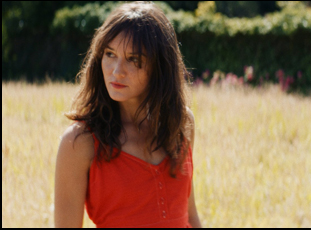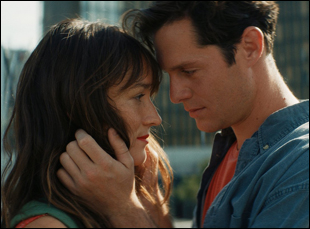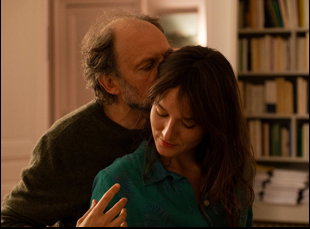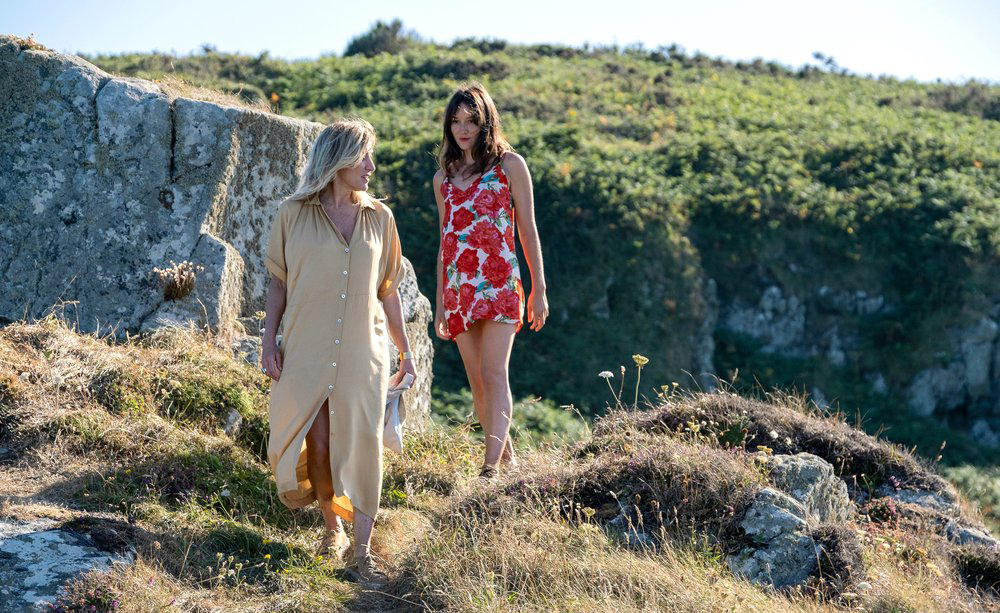It is the first of many deceptions in Charline Bourgeois-Tacquet’s wonderfully mischievous “Anais in Love” that you’re introduced to its title character, played with boundless energy by Anaïs Demoustier, fearlessly running through the streets of Paris. The sight of the headstrong young woman in a hurry to get home is exhilarating, but gradually Bourgeois-Tacquet reveals that she’s being driven by a feeling she needs to catch up, entering her thirties without a clear idea of what she should be doing with her life or whether or not there’s someone she could spend it with, if that’s even something she’d want. A pregnancy with her most recent partner Raoul (Christophe Montenez) isn’t the clarifying event that it would be for many, not giving even a thought to becoming a mother when she’s going through the excruciating pain of fearing her own will soon die of cancer, and although she gives her love freely, the only commitment she is willing to make is to her treasured books, which is the only thing she insists when renting out her apartment to AirBnB guests remain in the exact same place they were left.
A playful romantic comedy doesn’t often yield as much introspection as Bourgeois-Tacquet inspires with her inspired feature debut, but when Anaïs is always in a rush in spite of not knowing where she wants to end up, the film sees her enter an intriguing standstill after thrusting herself into the lives of Daniel (Denis Podalydès) and Emilie (Valeria Bruni Tedeschi), a longtime couple who separately become infatuated with her when they become restless in their own relationship yet are both unwilling to sacrifice the stability they’ve built over the years. A stark parallel is drawn between leading a life following one’s passion wherever it leads or the comfort once can take in predictability and although the writer/director is careful not to be too explicit in taking a side in the story she tells, the verve with which “Anais in Love” unfolds clearly indicate she’s a believer in the former, evading any notion of where you think things might go when Anais escapes the city for a countryside writers’ retreat.
While it’s an open question if Anais will end up with her soulmate, Bourgeois-Tacquet has found hers in Demoustier, who previously channeled all the energy of one of her lovelorn creations in the 2018 short “Pauline Enslaved” and has only built up even more steam over the years to put towards the force of nature in “Anais in Love.” Together, the two are bound to send the mind racing as much as Anais speeds in and out of the scenes from her hectic romantic life and after first premiering last year at Cannes’ Critics Week, the film is finally finding its way onto American shores this week and Bourgeois-Tacquet and Demoustier spoke about their collaboration, keeping up the film’s irresistibly relentless repartee, and working when the heat was on.
 After making “Pauline Enslaved” together, was a reunion a given?
After making “Pauline Enslaved” together, was a reunion a given?
Charline Bourgeois-Tacquet: After having worked with Anais on “Pauline,” we really felt that encounter was something we were going to continue collaborating on and then I rewrote the feature film which already existed prior to us shooting the short film with her in mind, taking into consideration some things that had worked well on the short film.
Anaïs Demoustier: The intimacy that I have with the character of Anais has a lot to do with the encounter with Charline because of the things that we share and what she knew of me and also what she wrote in terms of excesses, so it was a very, very pleasurable experience. When we act, we always bring something of ourselves and also want to be [dramatized] a little bit, so this is something that Charline’s writing really allowed for.
One of the character’s most distinctive traits is how active she is, always running. Was the energy something that was a challenge to transmit on screen without diluting?
Charline Bourgeois-Tacquet: That’s something that I think about a lot because my writing is so dialogue-based and I really never want to do “shot/reverse shot” in a classic way of framing dialogue, so the movement has to come from within. So the scenes are choreographed by me in advance where I [run through a scene] with my body and the [cinematographer and I] mark what the internal movement of a scene is going to be. That’s the only indication I give to my actors when I come on set.
Anaïs Demoustier: I think the physical requirement of this character was the key to her and also the doorway for me to work myself into it because there was a lot of text to learn and to integrate. I came to realize that to speak and think this much was a physical activity, so it is through her body and through my body guiding me that I was able to find that territory for her. And because the film is a film centering on desire, that was something that allowed me to have access to that in a full way.
 How did the environment feed into the production? It moves from the city to the country.
How did the environment feed into the production? It moves from the city to the country.
Charlene Bourgeois-Tacquet: It was very important it be shot in summer and the parts that are shot in the country really contributed to a very important element of the setting of the theme of desire and sensuality because all of these things for me answer each other. In terms of the actual production, we began by shooting in Brittany for three weeks and everybody got to know each other and then we were all able to get a certain work rhythm installed at this point and then we went from there to Nantes to shoot all of the Parisian apartments. That was a little bit more difficult. It was about 95 degrees Fahrenheit and that plus all of the lamps and all of that were conditions that we then had to readjust to.
One of my favorite scenes in the film is in an apartment when Anais is trying to rent out her place and she’s able to confide her inner thoughts to an audience when talking only to herself about why she’s leaving town with the Asian couple who’s come over to look at the place being none the wiser since she’s not speaking their language. What was it like to figure out when it’s such a difficult shot to pull off, moving around the apartment in a frenzy as she does?
Charline Bourgeois-Tacquet: I’m very happy you enjoyed it because I think it’s one of my favorite scenes also. I can’t really remember how the idea came about, but in terms of Anais’ character, it’s a big trait of hers that she’ll sometimes speak without paying so much attention to the person listening to her, so that was something that we were able to [have] there and then Anaïs Demoustier would be able to tell you she had some worries that it might sound artificial because this was such an extreme case of that where she really goes into it without paying attention. Then technically, we had this challenge of making it a long shot and it’s a very tiny space. We had to do 17 or 18 takes until we got it and an extra challenge of it was that the Korean actors who were there were nonprofessional actors, so miraculously they got a good sense of how [the scene] worked and when they had to move out of the camera’s way. They got the knack of it pretty quickly, but it was challenging and we had to do it quite a few times.
 Anaïs, was it difficult to get the tone right of this character who speaks at such a comically rapid clip but can be so bittersweet at times?
Anaïs, was it difficult to get the tone right of this character who speaks at such a comically rapid clip but can be so bittersweet at times?
Anaïs Demoustier: I would say that everything was right there in the script. I don’t think that finding that balance is work. It’s part of life that everybody has it in themselves — the comic and the tragic — and the situations that [Charline] was putting me in, all I had to do was play it. What we did need to work into it that was new was when I read the feature script, I found that the character could be enhanced to be a little bit more in the direction of the character in “Pauline Enslaved” in terms of her comedic [qualities], so I did pull the cover a little bit in that direction of adding some excessive qualities to enhance the qualities, but once that was done, the back and forth or the balance that we struck was just organic and I just had to show up for it.
Charline has made no secret of all of the personal touches from her life that have made their way into the film, from her past life in the book industry to the influences of Marguerite Duras and Cassavetes’ “Opening Night,” which are a part of the film in both direct and indirect ways. Is it interesting to step into that situation as an actress when the inspiration for the role is standing a few feet away from you at all times?
Anaïs Demoustier: I would say that in any situation, even when a director doesn’t write the character so closely related to themselves, we as actors step into the director’s life. This was a case in which it was all the more so because of how tied Anais as a character is to Charline and because of Charline’s similarities to me, there were all these ambiguities and all of these ways in which I could work from these areas of familiarity. It was great because in this case, I had Charline right there as a model for something to work towards, so sometimes I inspired myself quite directly and quite concretely from her in the way that she is in life, which is to say really physical and very concrete and very fast in the way that she moves about. I had the model for that right in front of my eyes, so it was something always between her, me and then this extra something, which was very amusing work.
“Anais in Love” opens on April 29th in Los Angeles at the Pasadena Playhouse, the Claremont 5, the Royal, the NoHo 7 and the Encino Town Center and becomes available on demand on May 6.




